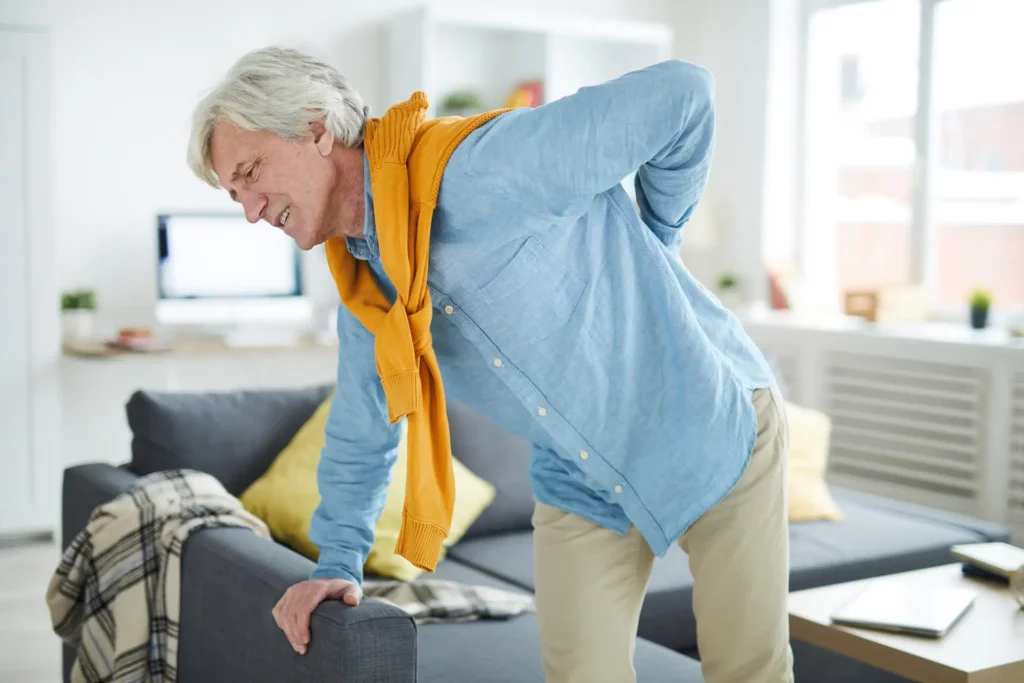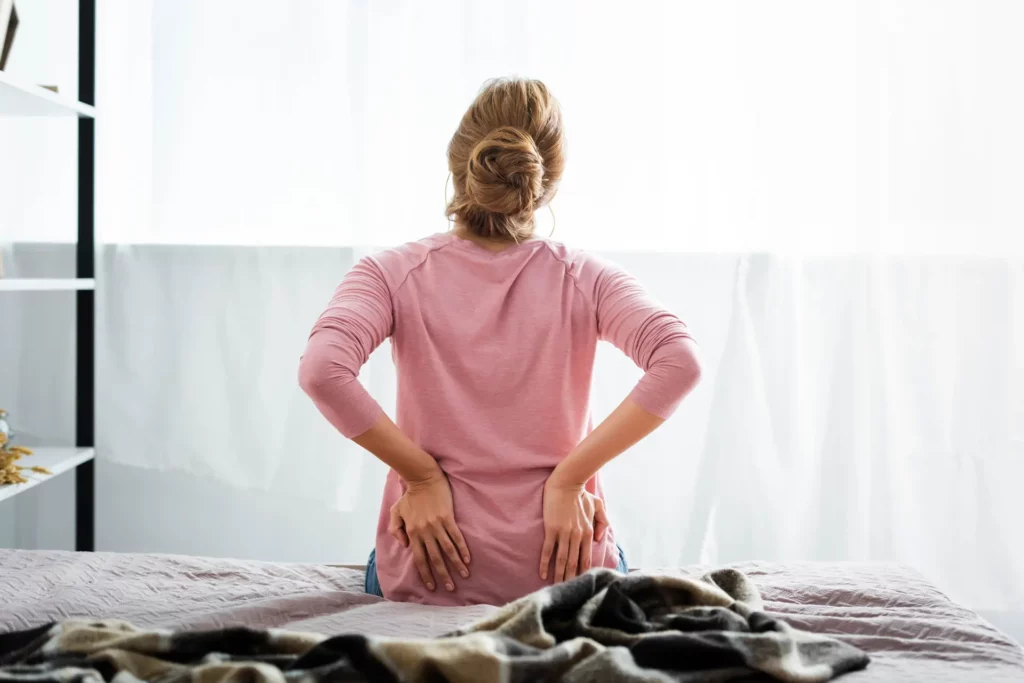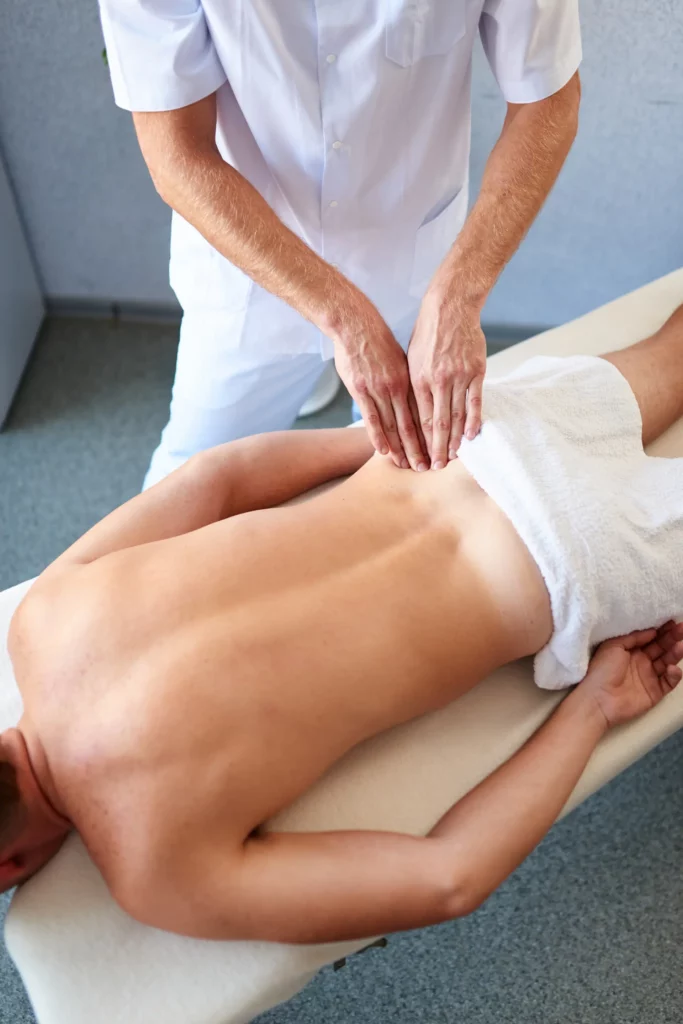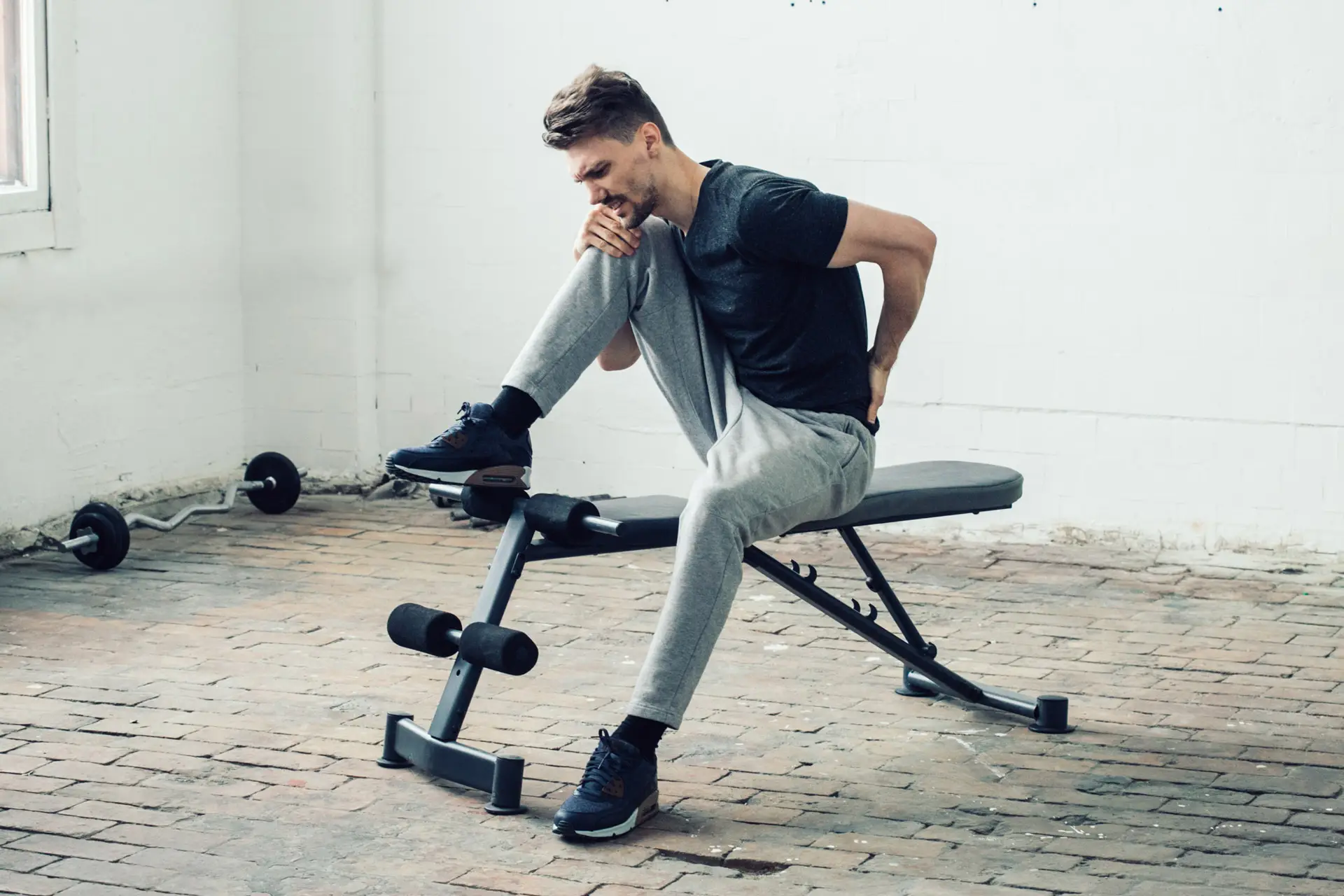Lower Back Pain
Lower Back Pain
The back is one of the most complex structures within our body. Not only that, but it’s also the backbone (quite literally) to all the necessary activities we engage in as humans on a daily basis: walking, standing, sitting, running, playing sports and even sleeping, all rely on a strong and supple back. When lower back pain strikes, not only can it be very painful and uncomfortable, but it can also have a significant impact on our lifestyle.
One in seven people is likely to experience a painful lower back in their lifetime. In the UK, it’s one of the leading causes of work-related absences. It can affect anyone at any age but is more common among the 35 to 55-year-old demographic. Often it arises due to how the bones, ligaments and muscles in the back all work together.
Though it can be debilitating, recovering from and treating lower back pain can be a straightforward process. Things get complicated, however, when the underlying cause is left untreated, and those suffering continue to engage in activities and treatments that are ultimately unhelpful.
If you’re feeling the strain, then our comprehensive guide to all things back pain is a great starting point where you can begin to understand what you might be dealing with and what you can do to help.

What is lower back pain?
Low back pain, otherwise known as lumbago, refers to any pain experienced in the lower lumbar region of the spine, though it can also be felt along the spine from the neck down to the hips. In general, it occurs between the bottom of the rib cage and the top of the legs. It affects a whopping 7 out of 10 people at some point in their lives.
It can come on suddenly or gradually and can also be the direct result of an injury or strain. It’s worth remembering that the back (especially the lower part) is complex in structure. That means that even the tiniest of awkward movements or damage to the region can lead to much more significant pain or discomfort. Often times, low back pain is a symptom indicative of a more underlying issue, say to a ligament, tendon, or disc. Even a pinched nerve can create a shooting sensation that can spread down to the legs (otherwise known as sciatica).
The good news is that most cases of back pain are entirely curable. The back is really good at healing itself, especially if aided along by regular activity and the right kind of exercise, stretches and rest. Pain usually lasts for a few days or a few weeks.
That being said, in some cases, lower back pain becomes more persistent and/or severe. If it gets to this stage, then it’s essential to seek medical instruction and advice or consult with a physiotherapist so that they can pinpoint the underlying cause and treat or even cure the pain.
What are the main causes of lower back pain?
Lower back pain can develop for a number of reasons ranging from lifestyle choices to injury, pre-existing conditions or a person’s medical history. While it can affect someone at any age, the older we get, the higher the chance maybe that we experience pain in our lower back. Particular occupations (e.g. those involving manual labour or excessive sitting) and degenerative disk diseases are risk factors that can lead to back pain developing as we age. Among other things, back pain has been linked with issues affecting the discs between vertebrae, the bony lumbar spine, ligaments, the spinal cord and nerves as well as lower back muscles and abdominal and pelvic organs.
Let’s cover a few of the more common causes of back pain:
Strain
One of the most common causes of back pain is, quite simply, strain. That could arise from injury, tension or pulling a muscle in the wrong way. Activities that could lead to a back strain or spasm range from lifting something the wrong way (or that is too heavy) to make an unusual, abrupt awkward movement.
Structural issues
The other, main category of lower back pain causes encompasses structural or skeletal problems. These include:
- Sciatica – A shooting pain that feels sharp and usually travels through the buttock down through the back and legs. It’s typically caused by a herniated disk that results in a trapped nerve.
- Arthritis – While osteoarthritis can cause many issues, lower back pain is one of them when it leads to a narrowing of the spinal cord (otherwise known as spinal stenosis).
- Kidney stones or infections – back pain can be caused by kidney stones or infections.
- Rupture or bulging disks – When the discs that cushion the vertebrae in the spine rupture or even begin to bulge, they can pressure the surrounding nerves leading to back pain.
- Abnormal spine curvature – Unusual spine curvature, including some cases of scoliosis, can cause pain across the back.
- Compression fractures – These are typically due to osteoporosis that leads to the spine becoming porous and brittle enough for compression fractions to form that are painful.
Posture & daily activities
Back pain most commonly stems from afflictions caused by lifestyle and everyday business. From sports to the posture we practice and maintain daily, back pain can spring up as a result of moving or standing in an unusual way: It’s possible to get back pain from the mundane action of twisting, sneezing and coughing, particularly if there’s underlying muscle tension. Bending awkwardly, or lifting, carrying, pushing or pulling improperly can also lead to strains. Even overstretching can do damage.
One of the most rampant causes of lower back pain is poor posture when sitting or standing uncomfortably for long periods of time. Whether it’s straining the neck or slouching at your computer, or driving for an extended period without a break, our modern society isn’t exactly set up in the most ergo-friendly way. Even your mattress could be lacking in proper support for optimal spinal alignment and health while you sleep.
Other causes
What are the symptoms of lower back pain?
There is a broad spectrum of lower back pain symptoms from mild or irritating aches and soreness to more severe, even debilitating, searing pain. Pain can come about suddenly or build-up gradually and can be sharp, constant or throbbing depending on the underlying cause. It can come and go or get worse over time. Some of the most commonly reported symptoms include:
One in seven people is likely to experience a painful lower back in their lifetime. In the UK, it’s one of the leading causes of work-related absences. It can affect anyone at any age but is more common among the 35 to 55-year-old demographic. Often it arises due to how the bones, ligaments and muscles in the back all work together.
Though it can be debilitating, recovering from and treating lower back pain can be a straightforward process. Things get complicated, however, when the underlying cause is left untreated, and those suffering continue to engage in activities and treatments that are ultimately unhelpful.
If you’re feeling the strain, then our comprehensive guide to all things back pain is a great starting point where you can begin to understand what you might be dealing with and what you can do to help.
- Muscle spasms
- Tight muscles in the back, hips and pelvis
- Stiffness in the lower back that makes walking, standing straight and sitting uncomfortably
- A sharp, stinging pain that moves from the low back through the hamstrings (Sciatica)
- Pain that increases after prolonged periods of standing or sitting
- Dull aches or soreness within the lower back region
- Acute pain – Typically the result of injury or tissue damage, acute lower back pain can last for up to a few days or weeks until it finally begins to subside as the body heals itself
- Subacute low back pain – This kind of pain can be more prolonged, lasting anywhere between 6-12 weeks. It usually stems from mechanical issues (joint pain, muscle strain, etc.). In cases like this, a medical examination is advisable, particularly if the pain persists and worsens to the point of affecting a patient’s daily activities.
- Chronic back pain – Any pain that lingers for longer than three months can usually be considered severe lower back pain. This kind of pain usually doesn’t respond to surface treatments and requires further medical analysis to pinpoint the cause of the pain.
Back pain can be further categorised as mechanical or radicular pain. Mechanical back pain, or axial pain, is by far the most widespread cause of lower back pain. Primarily deriving from joints, muscles and ligaments, this type of pain is often very localised to a specific area of the lower back or legs.
On the other hand, radicular pain arises when a spinal nerve root becomes inflamed. Usually, the sensation is a sharp or burning pain that can shoot down one side of the body (like sciatica).
How else can lower back pain impact your health?
Perhaps one of the most challenging aspects of lower back pain is that it can easily affect other bodily functions (such as movement in other areas) and, as such, affect your quality of life. Other areas that can be impacted by lower back pain are the hips, back of the legs, groin, even the knees. Lower back and hip pain, for instance, or leg pain are common grievances that we hear of.
For example, one of our readers, Neil, was experiencing knee pain as a result of their back pain. One of our gurus was quick to point out that pain often crops up in other areas due to the body compensating and ‘cheating’ when it’s forced to move poorly.
In other cases, back pain could be one of a few symptoms that’s linked to an underlying cause. When Obi wrote in about her mother having back pain as well as a hot sensation down one of her legs, one of our Gurus explained that it was more likely that both symptoms stemmed from the same root cause, and that’s what really needed to be identified and treated.
Yet another reader, Claire, had been suffering from backache and stiffness in both the lower and upper back while also beginning to experience weakness in one of her knees. Again, our approach here at Six Physio is about getting to and treating the underlying cause of the issue instead of throwing time and money at treatments that don’t address this.
It’s essential to recognize that back pain may lead to the overcompensation of other muscles in the body (and therefore strain in these areas) or that it can also be one of many symptoms showing that something else is going on.

How to treat, reduce and prevent lower back pain?
Treat lower back pain through self-care
- Resting – One of the simplest and most effective ways of treating a sudden onset of lower back pain is to rest simply. That being said, you shouldn’t prolong this for more than a few days, as relaxing too much can harm the healing process.
- Heating (or icing) the area – Whether its heat from a hot water bottle, warm bath or a heat wrap, this can be highly effective at easing muscle tension. In turn, the improved blood flow, in turn, delivers oxygen and nutrients to the muscles that need to be healed. When it comes to inflammation, you should use a cold pack or ice. Remember that with both heat and ice, you need to protect the skin during application.
- Modifying activities – Similar to resting, limiting specific activities that can worsen back pain can also speed up the recovery process. If, for instance, sitting at a desk is the culprit, set a timer for every 20 minutes to get up and stretch.
- Pain medication – Common over-the-counter anti-inflammatory medications such as aspirin, naproxen and ibuprofen can alleviate back pain due to swollen nerves and muscles. While other suggestions on this list don’t require additional medical guidance, it’s important to speak to a doctor if you’re unsure about any medicine and its side effects.

Manage and reduce lower back pain with exercise
Physical and physiotherapy can be instrumental in managing and gradually rehabilitate the lower back. There are an array of exercises for lower back pain that can help restore the spine, that includes:
Stretching – Since the muscles in your lower back, hips, buttocks and legs support the weight of the upper body, they need looking after. Generally, the more mobile you can be in these areas, the more you’ll be able to move freely and without injury. That being said, it’s important to strike a balance as overstretching can create more issues, as one of our readers Sally found out when she was experiencing back pain while continuing to practice yoga. Our guru advised that she stop any excessive yoga, emphasising ‘moving better’ over moving more while she healed.
With exercises for lower back pain, start slowly and gradually, using a specific muscle for only 20 to 30 seconds at a time. Never stretch beyond your natural limits and if the stretching is causing or worsening pain, stop immediately.
Strengthening – While stretching is important, strengthening the muscles around the lower back area is also a vital part of the rehabilitation process. Popular programmes include the McKenzie method which works on extending the spine and Dynamic Lumbar Stabilization which works on strengthening the back muscles for neutral spine alignment. When one of our readers, Martin, got in touch with a question around severe back pain, our Guru was able to recommend a few exercises to get his back moving again.

Summary
While never pleasant, lower back pain is something we’re all likely to run into at some point during lives. In a way, it’s part and parcel of living a normal life that requires us to move constantly. When your back is one of the main components of your body supporting that movement, it’s going to experience a bit of wear and tear.
That’s why it’s so important to take care of the health of our lower back, from stretching and strengthening the muscles that support it to practising proper posture and spinal alignment. At the end of the day, prevention is the best treatment. If you’re able to maintain a lifestyle when you can take care of your back, then it will take care of you.

